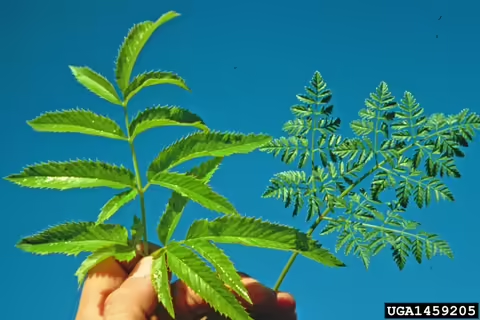
Originally published by Kelly Allsup on May 17, 2021.
Wild parsnip often makes headlines because of its negative effects on naïve gardeners and hikers. Wild parsnip along with giant hogweed and poison hemlock are types of carrots gone bad.
Each has negative impacts to human health, agriculture, and the environment and care should be taken in identifying and removing these misbehaving plants. To avoid the wrath of these infamous poisonous carrots, wear gloves, long pants, long sleeves and eye protection. Consider using herbicides over mechanical control. Wash any contaminated clothes separate from your family's clothing.
Wild Parsnip
The sap of wild parsnip poses a great risk to human health because sap in contact with skin in the presence of sunlight causes bad chemical burns. This condition is known as phytophotodermatitis. Wild parsnip (Pastinaca sativa) is a biennial native to Eurasia and is most abundant in the northern two-thirds of Illinois. The first-year rosette has leaves that are alternate on the stem. The leaves are compound (like ash or walnut) and have jagged teeth. The leaflets of the compound leaf are yellow and green on a grooved hairless stem. The flowers bloom the second year, causing it to stand 3 to 5 feet, and have an umbel — or flowering stalks growing out of a common center — of pale yellow that is reminiscent of dill. This plant prefers open areas like roadsides, old fields, prairies and ditches.
Giant Hogweed
Another invasive plant of great concern to human health is giant hogweed (Heracleum mantegazzianum) is on the federal noxious weed list that causes chemical burns on skin. If sap get in the eyes, blindness may occur. It is believed to be eradicated from Illinois, so if you suspect you have hogweed, please notify the Illinois Department of Natural Resources or your local Extension office. This plant looks like Queen Anne's lace on steroids. It is a biennial but can live for multiple years as a rosette before it sends up a flowering stalk. It is about 8-15 feet tall. The stem is hairy, hollow and has blotches of purple. It has large jagged toothed leaves. It has huge white umbel flower heads up to 2 feet wide. It prefers moist soils in partial shade like riverbanks, old railroads, or disturbed wooded areas and can be confused with cow parsnip or elderberries.
Poison Hemlock
Poison Hemlock (Conium maculatum) does not burn people but is considered an Illinois Exotic Weed. It has been on the rise in the past few years and was once planted as an ornamental. It is 5 to 12 feet tall, has leaves that are finely dissected and has a blotchy purple stem but is smooth. It has many small creamy white umbel flower heads. It is a biennial and does not flower until the second year. It prefers disturbed sites like roadsides and ditches. It is poisonous if ingested and is of great concern to cattle and horse farmers. Do not burn it as the inhaled smoke can be toxic.
Learn more about Illinois invasive species.
Main photo source: Giant Hogweed Leslie J. Mehrhoff, University of Connecticut, Bugwood.org
ABOUT THE AUTHOR: Kelly Allsup is a Horticulture Educator for University of Illinois Extension serving Livingston, McLean and Woodford Counties. She meets the educational needs of her community, including local chapters of Master Gardener and Master Naturalist volunteers, through expertise in home horticulture and entomology. Her passion for ecologically-friendly gardening and all things plants makes her a dynamic speaker on topics that range from beneficial insects, growing vegetables and fruits, to urban trees.

